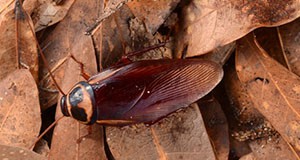Assessment-based pest management emphasizes the importance of evaluating the intensity of a pest problem before treating the problem. This 10-page fact sheet written by F.M. Oi, E. Weeks, J. Jonovich, and D. Miller and published by the UF/IFAS Entomology and Nematology Department explains the strategy and includes a decision flow chart to provide an easy-to-follow overview on how a German cockroach problem can be assessed and successfully managed with specific guidance for each of four levels described in the fact sheet. The levels described constitute an escalation protocol that may approximate the tiers in a LEED (Leadership in Energy and Environmental Design) pest-management plan and may meet the requirements of some “green” pest-management certification programs, depending on level.
http://edis.ifas.ufl.edu/in1190
Tag: Cockroaches
Australian cockroach Periplaneta australasiae Fabricius (Insecta: Blattodea: Blattidae)
Australian cockroaches are the most common outdoor cockroach in southern Florida. Though they typically stay outdoors, Australian cockroaches may also venture inside and live among humans. This 4-page fact sheet covers the Australian cockroach’s distribution and habitat, biology, medical risks to humans, and management as a pest. Written by Shiyao Jiang and Phillip E. Kaufman, and published by the UF Department of Entomology and Nematology, April 2015.
http://edis.ifas.ufl.edu/in1088
Florida Woods Cockroach Eurycotis floridana (Walker) (EENY514/IN915)
 This “peridomestic” organism can be found in structures near the home, such as storage areas, greenhouses, or shelter boxes for other structures such as water pumps. It is one of the species commonly referred to as palmetto bugs, and is also called a “stinkroach” or “skunk cockroach” due to its aromatic defensive secretions. This 6-page fact sheet was written by Christopher S. Bibbs and Rebecca W. Baldwin, and published by the UF Department of Entomology and Nematology, December 2011.
This “peridomestic” organism can be found in structures near the home, such as storage areas, greenhouses, or shelter boxes for other structures such as water pumps. It is one of the species commonly referred to as palmetto bugs, and is also called a “stinkroach” or “skunk cockroach” due to its aromatic defensive secretions. This 6-page fact sheet was written by Christopher S. Bibbs and Rebecca W. Baldwin, and published by the UF Department of Entomology and Nematology, December 2011.
http://edis.ifas.ufl.edu/in915


